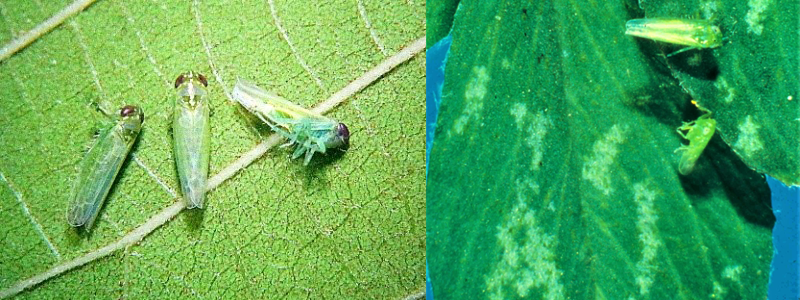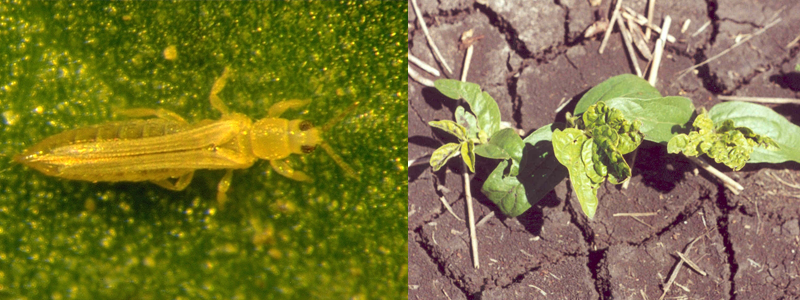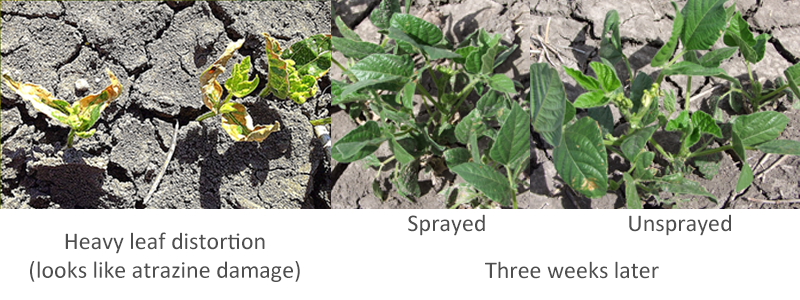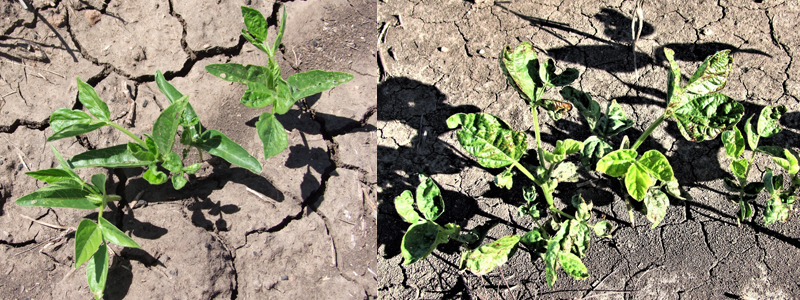Leafhoppers (also known as jassids) and seedling thrips are extremely abundant in Central Queensland this summer.
The vegetable leafhoppers (Austroascra viridigrisea) are very much an ‘in your eye’ pest, with swarms of the small (3mm) bright green critters flying up when disturbed in-crop. In contrast, the cotton seedling or cereal thrips (Thrips tabaci) are hiding out of sight, down in the growing points of the plants. Many crops are harbouring both pests but the most striking damage symptom, badly distorted leaves, is only inflicted by one of them.
The leaf distortion is caused by thrips while the leafhoppers cause pale feeding marks or stipples on the leaves.

Vegetable leafhoppers and their stippling damage.

Seedling thrips and typical spring crop damage.
Extremely high vegetable leafhopper populations would be required to inflict economic damage and the threshold reflects this. The threshold of 250 leafhoppers per 10 sweep net sweeps across one row in a crop with 1m row spacing (for 50 cm rows, sweep across 2 rows and for 25 cm rows, sweep across 2 rows, and double the counts) means that in general, vegetable leafhopper populations rarely need to be controlled.
In southern Queensland, the same applies – control of seedling thrips is rarely warranted. The image below shows very obvious thrips damage in a spring mungbean trial where the damage illustrated had no impact on yield or time to harvest. Note that in southern Queensland, seedling thrips damage is usually confined to spring crops, particularly those crops with adjoining winter cereals that thrips can move from.

Thrips damage on the Darling Downs – the plants successfully grew out.
These images show a crop with even greater damage, resembling that caused by herbicides. In this case, the grower opted to spray, but on request, left some unsprayed strips. Three weeks post spray there was no visible difference between sprayed and unsprayed plants, a finding that would have not been possible without the unsprayed strips.
Seedling thrips impact in CQ mungbeans is an area requiring further research. In southern Qld, seedling thrips attack is usually confined to spring crops, and populations usually peak during the early vegetative stages, giving plants plenty of time to recover with no impact on yield. However in CQ, there seems to be more sustained and longer thrips pressure, in summer as well as spring crops. Some crops (see images below) had light damage (comparable to a Darling Downs crop), but others had severe damage inflicted by prolonged thrips attack.
In the summer crops in particular, the source of the thrips needs investigation. In 2020, it may have been the prolific weed and pasture grasses in and surrounding the mungbean crops.

The impact of thrips damage in CQ can vary widely. Light damage with no need to spray (left) and severe damage due to sustained thrips pressure.
The severe damage pictured will most likely reduce yield, and control is likely be warranted to allow further leaf growth and prevent even greater yield loss. However, it is always wise to leave unsprayed strips to test these assumptions.
Check for thrips presence before making any management decisions. Note that dimethoate® is registered at 800mL/ha for seedling thrips, but is very hard on beneficials. For this reason, we cannot recommend prophylactic spraying of thrips, or spraying where damage is slight. If dimethoate is unavailable, there is a permit for Abamectin (PER 80936) at 300 mL/ha (valid till October 2020).
Article prompted by observations from the recent GRDC Pulse Check field days in CQ.
